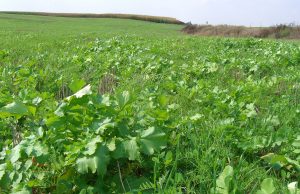Kevan Klingberg, kevan.klingberg@wisc.edu
UW Discovery Farms
Planning for the cropping season and then getting those seeds in the ground is an endeavor that involves a lot of capital, labor and “go-time” activities. Now, due to rain and more rain, Wisconsin farmers enter the summer with an unusual number of unplanted fields. “Go-time” got rained out, leaving farmers to decide on a plan-B, as it is too late to plant the original crop. Soil conditions will eventually dry, and most of this land will be able to support farm equipment later into summer.
What are you going to do?
If you need livestock feed, explore alternative forage and energy crops with your agronomist. As always, consult with your crop insurance agent, agronomist, and others for complex field decisions. And, if your unplanted acres are not required for feed and need to be cared for until next growing season, summer is a great time to plant a cover crop.
What should you plant?
Maybe you are considering cover crops for the first time. If so, aim to keep it simple and affordable with a realistic establishment plan. There are many plant species and seed mixes to consider. With 90 plus days of the growing season still out there, it will serve you best to choose a mix of plant species. Growing a grass and broadleaf mix adds biological diversity above and below the ground and can enhance soil productivity into the future.
Practically speaking, planting a mixed species cover crop will help to 1) protect against soil loss; 2) compete against weeds, and 3) cycle nutrients on your land. The Midwest Cover Crops Council website (http://mccc.msu.edu/) is a good online resource to familiarize yourself with different cover plant species, their ecosystem functions, and their agricultural management details.
As an example, consider a seed mix of radish, medium red clover, oats, and cereal rye (Table 1). This seed, including clover inoculation, will cost about $30.50 per acre. Cover crop seed cost will vary depending on chosen species, planting rates, and vendors. As you aim for a total seeding rate of 40-60 pounds per acre, you can adjust any seed mix and planting rates as needed. For example, when considering future crop nitrogen needs, if crop year 2020 will be corn, keep the clover; if 2020 will be soybeans, remove the clover and adjust planting rates for a lower seed cost, around $21.75 per acre (Table 2).
All the plants in these mixes provide good vegetative cover to protect the soil and compete with weeds. Radishes, oats, and cereal rye will scavenge and recycle soil nutrients; and the medium red clover fixes nitrogen into the next season.
Table 1. Example cover crop seed mix for next year corn

Table 2. Example cover crop seed mix for next year soybean

* Upper Midwest seed dealer, spring 2019.
**Pure live seed, germ test and adjust plant rate.
Aim to plant in mid-July to keep the radish vegetative and delay it bolting up a seed head. Either of these cover crop mixes can easily be established by burning weeds down with glyphosate herbicide and planting with a no-till grain drill.
Based on your equipment line up, establishment could also include tillage and a regular duty grain drill, or broadcast spread the seed mix followed by a shallow soil incorporation. However you decide to plant, always include burn down herbicide or tillage as an up-front weed control or the cover seeding will struggle.
There are many things to consider once your early saturated fields are finally dry enough to farm. Do you plant late, change crops, grow forage, or collect insurance? Consider planting a summer cover crop as a plan-B on land that was too wet to farm earlier. A mixed species cover crop will protect against soil loss, compete against weeds, and cycle nutrients as you look forward to crop year 2020.
Additional Resources:
UW Cover Crops in Wisconsin: https://fyi.extension.wisc.edu/covercrop/
UW Crops and Soils, Dealing with extreme weather:
https://fyi.extension.wisc.edu/grain/extreme-weather/
Midwest Cover Crops Council http://mccc.msu.edu/USDA, WI NRCS, WI Agron Tech Note 7. Cover and Green Manure Crops Benefits to Soil Quality. https://efotg.sc.egov.usda.gov/references/public/WI/TN_A7-(2017-02).pdf
- Land spreading milk due to market disruption - April 15, 2020
- Zero-nitrogen test strips evaluate Nitrogen Use Efficiency in corn - August 8, 2019
- Wet unplanted land:Use cover crops to save soil, fight weeds and cycle nutrients - June 18, 2019
